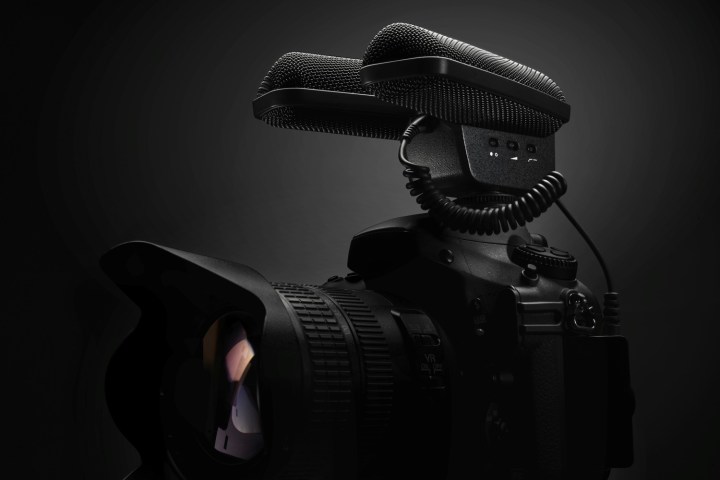
The MKE 440 is Sennheiser’s newest compact stereo shotgun microphone for higher-end cameras, such as DSLR and mirrorless models, as well as advanced compacts that have a mic-input, like the new Sony Cyber-shot RX10 III. Unlike a typical mini shotgun mic, which record audio from the side, the MKE 440 actually has two, placed in a V-shape, that captures sound from the direction the camera is pointing at. This, Sennheiser says, lets filmmakers record a “well-balanced mix between ambient sound and clearly comprehensible speech and dialogue … from within the direction of filming and rejects the majority of off-axis noise from outside the camera focus.” Besides filmmaking, the microphone could come in handy for users like independent journalists reporting from the scene, for example.
“The result is what I would call picture-matched stereo ambiance,” said Kai Lange, product manager in Sennheiser’s broadcast and media division, in a release. “For example, this lets filmmakers capture comprehensible dialogue with just enough ambient sound to preserve the atmosphere of a scene.”

The MKE 440, which fits into the camera hot shoe, is shock-mounted to reduce handling noise, and has a stainless steel cover to limit wind noise. A cover is included, for those really windy moments. It has a three-level sensitivity switch (soft to loud sounds), and a low-cut filter for eliminating low-frequency noise that can be turned off. The microphone lasts four hours continuously on two AAA batteries. The MKE 440 will go on sale in June, with pricing to be determined.
GoPro cameras aren’t stellar when it comes to audio capture — to the point that they are sometimes unusable. Sennheiser is currently developing a new waterproof microphone that attaches directly to the side of a GoPro underwater housing. The mic would allow clearer audio during action situations in rugged environments, whether it’s surfing or snowboarding — even underwater.

Currently, the higher-end Hero4 models accept an external microphone via a Mini USB adapter, but the dangling wire isn’t exactly elegant, especially for the just mentioned scenarios. With this mic, which connects electronically using the camera’s BacPac port, you can finally capture sound that matches the video, instead of having to overlay music.
The GoPro microphone, which doesn’t have a name yet, is the result of collaboration between Sennheiser and GoPro, via GoPro’s new Developer Program. As a partner, GoPro provided the tools and feedback that allowed Sennheiser to create a microphone that maximizes the camera’s potential. During GoPro’s Developer Program debut in San Francisco, Sennheiser showed us a prototype (it’s currently undergoing testing, with pricing and availability to be announced later) along with sample videos.
In the videos, Sennheiser recorded scenes using the onboard mic and external mic, in various action scenes. The difference is clearly noticeable: Audio from the onboard mic is garbled and with low volume. In a water scene, it sounded like a running faucet. With the Sennheiser mic, you can clearly hear the audio and pick out distinct sounds, like voices. That running faucet sounded more like splashes of water.
We hope Sennheiser puts an attractive price on its GoPro microphone, because it will finally deliver the missing puzzle piece — audio — from GoPro videos.
In related news, at the GoPro event, Sennheiser also previewed a prototype of an upcoming VR microphone that will launch in late 2016, which we first saw at CES 2016. Also built as part of the GoPro Developer Program, the Ambeo mic is designed to work with 360-degree VR rigs that utilize GoPro cameras (possibly GoPro’s Omni). Like the aforementioned GoPro mic, the idea here is to capture better sound quality that what the onboard mics can muster.
However, because the Ambeo is recording sound for a VR experience, it has to capture a true audio representation of the environment. That means, when you reposition your head in a different direction, that sound needs to feel natural. To achieve that, the microphone is composed of four capsules that face different directions.
In a VR demo, we watched a pianist playing inside an empty room. As we face the pianist, the music is clear and loud, as if you’re watching a live performance. When you turn around and reposition your view, the audio changes accordingly — as it would in real life. This is what Sennheiser is referring to when it says the microphone captures realistic audio — from a single microphone instead of many. You can find out more about why audio is a key component of VR, in our feature about Ambeo.


